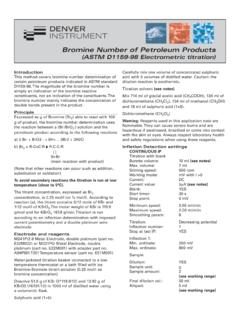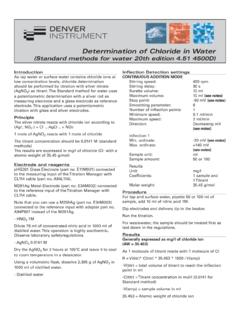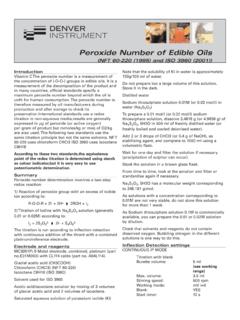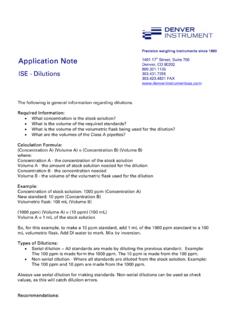Transcription of (Perchloric acid titration ASTM 2896-01 and ISO 3771)
1 IntroductionThe Base Number determination is a measurement ofthe basic constituents of petroleum products. Thistitration uses perchloric acid in glacial acetic acid astitrant in a specific non-aqueous titration performs an inflection point determinationtaking into account the total volume of titrantnecessary to detect an inflection result is expressed as mg of potassium hydroxidefor 1 g of titrant concentration is and the molar weightof KOH is g/molIf the titration curve is poorly defined with no inflectionpoint detected, it is necessary to run a back titration (see "back titration " note).Electrode and reagentsAs the titration occurs in nonaqueous media, it isrecommended to work with separate electrodes and athree-electrode system (see electrode maintenanceand storage notes).pHG311 Glass Electrode (part ) with aCL114 cable (part no. A94L114) as measuring electrode,REF451 (part no.)
2 E21M005) with salt bridge filled withsaturated NaClO4in glacial acetic acid with a CL114cable (part no. A94L114) as reference electrode (seeReference electrode note), M241Pt Metal Electrode(part no. E31M001) as cell solventAdd one volume of glacial acetic acid to two volumesof perchlorate electrolytePrepare a saturated solution of sodium perchlorate(NaClO4) in glacial acetic in CH3 COOHMix ml of 70 to 72% HClO4with 500 ml of glacialacetic acid and 30 ml of acetic anhydride anddilute to 1000 ml with glacial acetic the solution using potassium hydrogenphthalate (see standardisation note).This solution is also commercially buffer solution (part no. S11M012) and buffer solution (part no. S11M014)Warning:Some reagents used in this application noteare flammable. Others can cause severe burns and arehazardous if swallowed, breathed or come into contactwith skin or eyes.
3 Always respect laboratory health andsafety regulations when using these reagents. Alsorefer to the ASTMI nflection Detection settingsCONTINUOUS ADDITION MODE (CONTINUOUS IP)Cell grounding: M241 PtBurette volume: 25 mlMeasure: mVBlank: YESMin. ordinate: 400 mV(see "ordinates" note)Max. ordinate: 700 mVStirring speed: 600 rpmStirring delay: 30 sMaximum volume: 15 ml(see "maximum volume"note)Stop point: 750 mV(see "ordinates" note)Direction: Increasing mVMinimum speed: ml/minMaximum speed: 1 ml/minSmoothing parameter: 5 Inflection points number: 1 Inflection1 Min. ordinate: 400 mV(see "ordinates" note)Max. ordinate: 700 mVBase Number of Petroleum Products (Perchloric acid titration astm 2896-01 and ISO 3771) Stop at last IP: YESS ample unit: gSample amount:see working rangeResultsNumber of results: 1 Result unit: mg/gMolar weight: : 1 smp + 1 titrProcedure (using 120 ml of titrationsolvent)It is strongly recommended to work under a hoodFor the first use, prepare the REF451 REF451 is delivered with the salt bridge filled withaqueous KCl solution, empty this solution, then rinsethe bridge with water then with acetic acid and fill itwith the Base Number of Petroleum Products (Perchloric acid titration astm D 2896-01 and ISO 3771) saturated solution of sodium perchlorate (NaClO4) inglacial acetic the electrode behaviour:Measure the potentials reached by the electrodesdipped in the pH and then in the pH buffersolutions.
4 The difference between the twomeasurements should be at least 330 this, use the ELECTRODES and "DISPLAYMEASUREMENT" a blank determination using 120 ml of the sample by dilution of the necessaryamount of product in 120 ml of titration the indicated before, results are expressed as mg/g ofKOHR(mg/g) = (Vt - Vb) * Ct * /WVt = Total volume of titrant used in mlVb = Blank volume used for solvent titrationCt= Concentration of titrant in mol/lW = Sample weight in = molecular weight of KOHR esults on 2 different oil samplesBlank volume for mlOil 1 Mean on 2 testsTBN: mg/gOil 2 Mean on 2 testsTBN: mg/gWorking rangeAccording to the calculation formula for 1 g of productand using a 25 ml burette, the experimental range isbetween 5 mg/g and 110 mg/g for the Base addition, astm D2896-01 gives for the sample sizediluted with 120 ml of solventThis table corresponds to an approximate titrantvolume of mlElectrode maintenance and storagea) When a titration is finished, rinse the electrodes withtitration solvent, then with distilled water and dip themin the pH buffer solution for 30/60 seconds.
5 Beforestarting a new experiment, rinse electrodes withtitration solvent. Depending on the oil, it is possibleto use another solvent instead of the titration ) After a cycle corresponding to 5/10 titrations , changethe measuring glass electrode. Clean it with titrationsolvent, ethyl alcohol and distilled water and store it inpH buffer ) Every morning or before starting a new titrationcycle, check the electrode system. Measure thepotentials reached by the electrodes dipped in the and then in the pH buffer solutions. Thedifference between the two measurements should beat least 330 ) Once a week, clean the glass electrode using theRadiometerNotesReference electrodeInstead of the REF451, it is possible to use theREF361 Reference Electrode (part no. E21M003) filledwith LiCl 1M in isopropanol. Using this electrode, it isnecessary to change the potential ordinates; asexperimental values you can note:Stop point: 950 mVMin.
6 Ordinate: 700 mVMax. ordinate: 850 mVMaximum volumeDepending on the expected result, it can be necessaryto modify this setting (especially in continuous IP).Enter a maximum volume corresponding to 2-3 mlabove the last inflection ordinate values are experimental values withthe mentioned titration solvent and electrodes. If thereference electrode or titration solvent are changed, itshould be necessary to modify the different ordinatevalues. Sample weight in gExpected Base No. 1-5 112-28 280-112 Titrant standardisationIf necessary, standardise the titrant against weighedpotassium hydrogen phthalate (KOOC-C6H4- COOH with a molar weight of g/mol and 1 smp + 1titrant). Take g of potassium hydrogen phthalateweighed to the nearest mg. Dissolve it with care in20 ml of warm acetic acid , add 40 ml of chlorobenzene,cool and out a blank titration on 20 ml of acetic acid plus40 ml of titrationIf no inflection point is visible during direct titration , itis necessary to run a back titration to determine theBase this case, a known volume (in excess) of acid in acetic acid is added to the samplediluted in the solvent titration .
7 The excess of perchloricacid is back titrated with sodium acetate in acetic acidas sodium acetate solutionUsing a volumetric flask, dilute g of Na2CO3(anhydrous sodium carbonate) in 300 ml of acetic acid ,after dissolution, complete to 1000 ml with acetic acid (the molar weight of Na2CO3is 106 g/mole and 1 moleof Na2CO3gives in acetic acid 2 moles of CH3 COONa).Procedure according to the astm standardUsing titration solvent as solvent, titrate a knownvolume of perchloric acid (for example 8-10 ml) withthe sodium acetate solution. Note the volume V1of thesodium acetate no more than 5 g of product and add the samevolume of titration solvent and the same volume ofperchloric acid that should be in the solution with the sodium acetate solution,note the volume Cac is the titrant concentration and W the sampleamount:BN (mg/g) = ((V1-V2)*Cac* )/WCurvesBlank solventSampl







